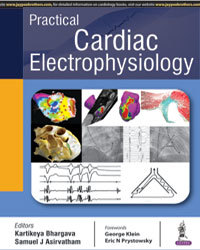Practical Cardiac Electrophysiology
Auteurs : Bhargava Kartikeyan, Asirvatham Samuel J

Electrophysiology studies test the electrical activity of the heart to determine the source of an arrhythmia.
This book is a comprehensive guide to cardiac electrophysiology providing a thorough understanding of the mechanisms of arrhythmias and therapeutic interventions used in their treatment.
Beginning with an introduction to cardiac electrophysiology and the fundamentals of cardiac anatomy, imaging, mapping and ablation, the following sections cover the diagnosis and management of different types of arrhythmia.
The final section discusses miscellaneous topics including entrainment, provocative drug testing in the electrophysiology lab, and catheter ablation in children.
The book is highly illustrated with nearly 300 images and tables and each chapter concludes with a summary highlighting the main points of the topic and offers suggestions for further reading.
Key points
- Comprehensive guide to diagnosis and treatment of cardiac arrhythmias
- Provides thorough overview of cardiac anatomy, imaging, mapping and ablation
- Includes other topics such as provocative drug testing and catheter ablation in children
- Highly illustrated with nearly 300 images and tables
Section A: Introduction and Basics of Cardiac Electrophysiology
- Electrophysiology Study: Indications, Hardware and Set-up, Catheter Placement
- Electrophysiology Study—Technical Details, Electrograms, Noise and Filtering
- Measurements of Basic Intervals, Refractory Periods and Programmed Electrical Stimulation
- Sinus Node Function Evaluation and Abnormalities
- Atrioventricular Conduction and Block
Section B: Fundamentals of Cardiac Anatomy, Imaging, Mapping and Ablation
- Cardiac Anatomy for Electrophysiologists
- Imaging in Cardiac Electrophysiology
- Conventional Mapping Techniques—Fundamentals
- Three-dimensional Mapping of Cardiac Arrhythmias: Techniques, Principles and Application
- Radiofrequency Ablation—Principles and Biophysics
- Non-Radiofrequency Sources of Ablation
Section C: Supraventricular Tachyarrhythmias—AV Node-depedent Tachycardias
- Basic Supraventricular Tachycardia Study—Approach
- Supraventricular Tachycardias: Baseline Features during Sinus Rhythm and Tachycardia
- Ventricular Pacing Maneuvers for Diagnosis of Supraventricular Tachycardia
- Supraventricular Tachycardia: Atrial Pacing Maneuvers
- Atrioventricular Nodal Reentrant Tachycardia: Classification, Electrophysiological Features, and Ablation
- Wolff-Parkinson-White Syndrome and Atrioventricular Accessory Pathway-related Arrhythmias: Localization, Mapping and Ablation
- Mahaim Fiber Accessory Pathways and Other Variants of Preexcitation
- Junctional Tachycardia
Section D: Supraventricular Tachyarrhythmias— Atrial Tachycardia, Flutter and Fibrillation
- Focal Atrial Tachycardia and its Differentiation from Macroreentrant Atrial Tachycardia
- Atrial Flutter: Classification, Mechanisms and Management
- Atrial Fibrillation—Classification and Mechanisms of Initiation and Maintenance
- AF Ablation: Pulmonary Vein Isolation Techniques, Strategies and Principles
- Atrial Fibrillation Ablation–Substrate Modification and Other Strategies
- AV Junction Ablation for Rate Control in Atrial Fibrillation
- Atrial Fibrillation Ablation: Clinical Studies, Efficacy and Complications
- Surgical Ablation for Atrial Fibrillation
- Atrial Arrhythmias in Congenital Heart Disease and Post Cardiac Surgery
Section E: Ventricular Tachyarrhythmias
- Introduction to Ventricular Arrhythmias—Premature beats, Monomorphic Ventricular Tachycardia, Polymorphic Ventricular Tachycardia, and Fibrillation
- Monomorphic Ventricular Tachycardia: Mechanisms and Etiology
- Ventricular Tachycardia in Ischemic and Non-ischemic Cardiomyopathy— Reentrant Circuits, Mapping Techniques and Ablation Strategies
- Ventricular Tachycardia in Arrhythmogenic Right Ventricular Dysplasia/Cardiomyopathy
- Ventricular Tachycardia in Specific Cardiomyopathies - Sarcoidosis and Tuberculosis
- Idiopathic Left Ventricular Tachycardia
- Idiopathic Outflow Tract Ventricular Tachycardia
- Idiopathic Ventricular Tachycardia from the Mitral Annulus, Papillary Muscles and Other Sites
- Bundle Branch Reentry: Mechanisms, Diagnosis and Management
- J Wave Syndromes
- Early Repolarization Syndrome and Risk of Sudden Cardiac Death
- Idiopathic Ventricular Fibrillation—Mechanisms and Management Strategies
- Ventricular Arrhythmia Storm—Etiology, Mechanisms and Management
Section F: Miscellaneous
- Entrainment: Principles and Clinical Applications
- Wide QRS Complex Tachycardia: An Electrophysiologic Approach
- Provocative Drug Testing in the Electrophysiology Lab
- Catheter Ablation in Children
- Epicardial Ablation: Techniques and Applications
Kartikeyan Bhargava
Senior Consultant, Cardiologist and Cardiac Electrophysiologist, Medanta Heart Institute, Gurgaon, Haryana, India
Samuel J Asirvatham
Consultant, Division of Cardiovascular Diseases, Mayo Clinic College of Medicine, Rochester, Minnesota, USA
Date de parution : 11-2016
Ouvrage de 950 p.
21.5x27.9 cm
Disponible chez l'éditeur (délai d'approvisionnement : 14 jours).
Prix indicatif 218,47 €
Ajouter au panier


